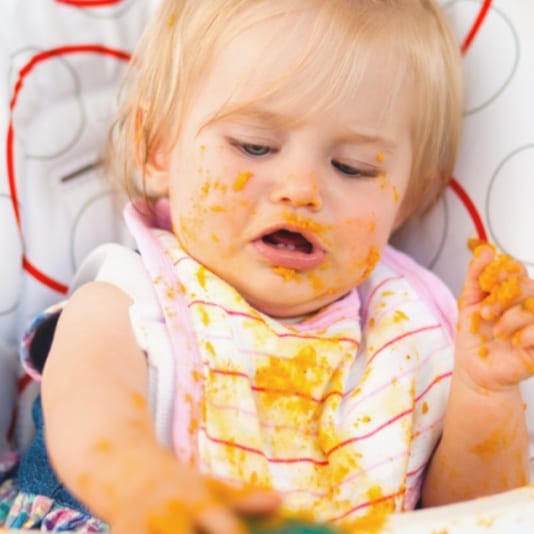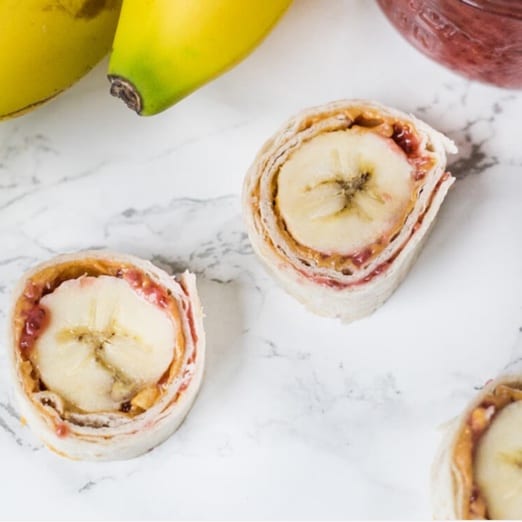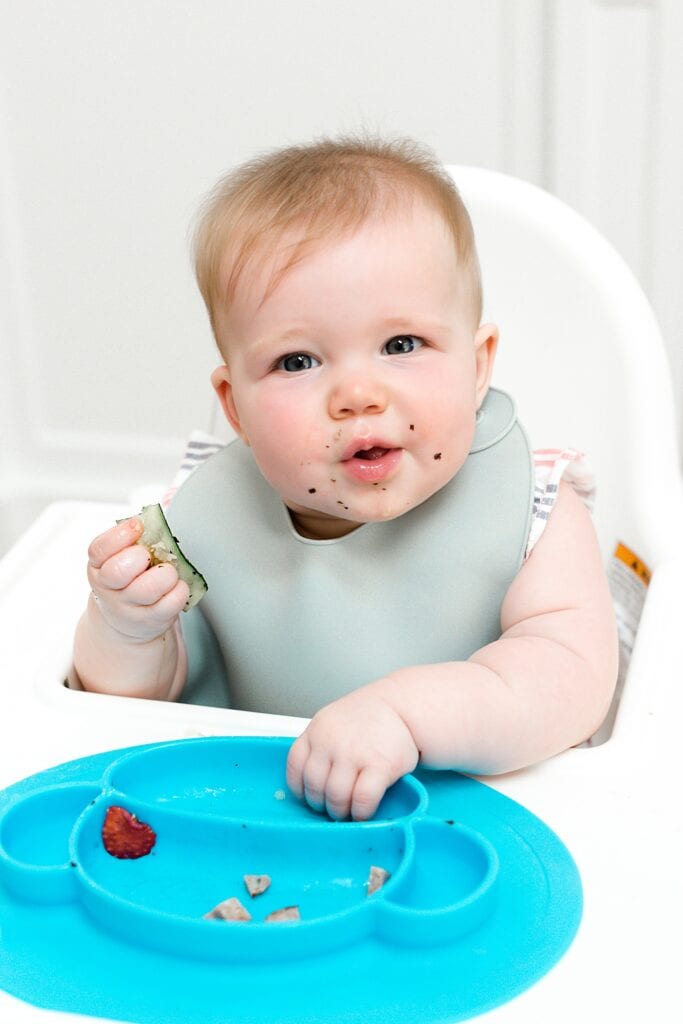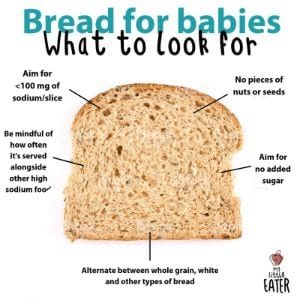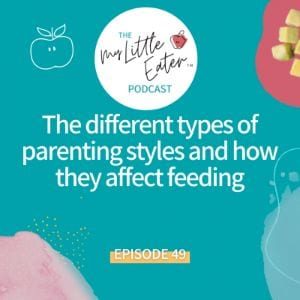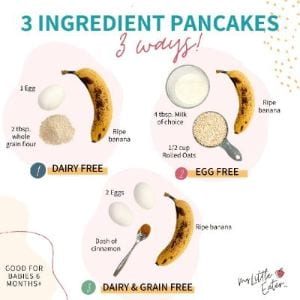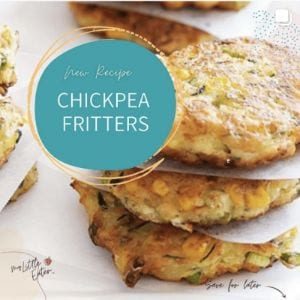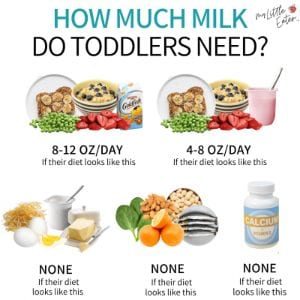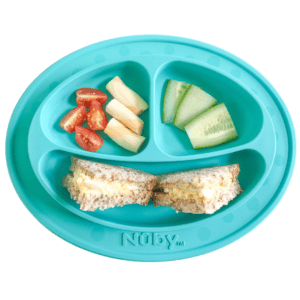
Are you forever wondering how to make meals and snacks for your toddler so that they get all of their nutrients in the run of a day? Or how to build them in a way that it actually fills your toddler up so that they’re not asking for another snack half an hour after you just gave them one?
Well, Mama, don’t worry… I’ve got the trick for you! Let’s talk about my golden rule that I use every time I’m building out meals and snacks…not only for my kids, but for my husband and I too!
But first, let’s talk about why it’s so important to build out meals and snacks a specific way.
Why having a formula for building out balanced toddler plates is important:
1. It increases the chances that your child gets in all the nutrients they need in a day.
When you have a formula that ensures you’ve got all your bases covered for all the essential nutrients (and it shows up every time you serve something), you can rest assured that, even if your toddler doesn’t eat something for one meal, they’ll get the opportunity to get those nutrients in again (in enough quantity) at the next meal. Usually we see supper is the most well rounded offering in terms of nutrients (we tend to think of including a protein, carb, vegetable, fruit), but breakfast, lunch and snacks are most often missing components. This means, there’s only 1 or 2 chances a day for your child to get in certain nutrients – and since we know toddlers are finicky and may choose not to eat at certain meals at all – we need to maximize each meal to ensure it’s fully balanced with a specific formula.
2. It balances their blood sugars and prevents them from getting hungry in between meals and scheduled snack times.
Unsatisfying snacks and meals can be very frustrating for both toddlers and parents! It can also make it very hard to stick to a feeding schedule for your toddler (which I strongly believe in!) because your toddler is actually truly hungry in-between meals!
Here’s what happens.
Many meals or snacks are comprised of quick release carbs, which will cause your toddler to get hungry again in as little as 30 min-hour later (or should I say hangry). Quick release carbs are found in foods like most granola bars, crackers, fruit, puree pouches, pasta, oatmeal etc. While they do provide a good source of energy, on their own, they don’t have any fat or protein to stabilize blood sugar levels for any decent length of time. Basically, quick release carbs (aka most low fiber foods) can increase blood sugar levels quickly (think of the “sugar high”), then they drop shortly after, causing toddlers (and adults) to seek out the next and best food that will give them another boost of quick release carbs! More balanced meals will allow blood sugar levels to remain stable and keep your toddler full until the next opportunity to eat!
Providing balanced meals can also give you peace of mind when your toddler says they are hungry half an hour later, but you know they just ate a fully balanced meal/snack that shouldn’t leave them feeling that way. It helps you to narrow down when they might in fact be eating out of boredom, or to satisfy emotional needs, OR because stereotypical snack foods are oh-so-LOVED by all toddlers. A balanced meal should allow a toddler to go 2-3 hours before needing to eat again, and 3-4 hours for a preschooler or older child!
3. It ensures enough exposures to varied types of food.
When meals/snacks are balanced, you know you have a variety of different foods presented, which allows for more exposure to foods that may not usually get offered! Constant exposure to varied food groups can help your toddler overcome and/or prevent picky eating. When you have a formula to create balanced meals and snacks, it removes all the guesswork and you don’t need to worry whether you’ve exposed them to a certain food group enough!!
Not only are you getting varied exposures to the three macronutrients, you will likely be also getting more exposures to produce which can often be a “trouble area” for some toddlers! While it can be hard to make produce show up at every meal and snack, I want you to really strive to offer fruits and veggies as much as you can!
Action step: I want you to focus on including a fruit or veggie in at least one snack per day for your toddler. This ensures nutrient needs are met and that they are getting in a variety and more exposures throughout the day!
How I recommend building balanced meals and snacks
Over my years of experience as a pediatric dietitian, I’ve found an easy formula for building meals and snacks that I always teach my clients. I call this formula the FFP rule, and I see it as a golden rule for building your toddler’s plate for both meals and snacks.
FFP stands for Fat, Fibre, and Protein. The rule is that every meal should include a substantial source of each of these nutrients!
This doesn’t mean a couple grams of each one. Really, I like to aim for at least 3-5 grams of fiber per serving, 3-5 grams of fat per serving, and 5-10 grams of protein per serving of a food to satisfy the criteria of having a “substantial” source of each nutrient on the plate.
Here’s a brief description of why each of these components are important:
Fat (specifically a healthy fat source)
- Fat helps with the absorption of fat-soluble vitamins, such as vitamins A, D, E, and K. Without it, these vitamins can’t be absorbed! Providing a source of fat in a meal or snack is also crucial for filling up your toddler! A lot of parents worry about high fat sources for kids who are overweight, but this rule should stay firm even for those kids. Without the satiety benefits it provides, you’ll leave your toddler looking for more food in a jiffy, and feeling starved, which just exacerbates the problem. Plus…it’s essential for growth (at the cellular level and beyond), hormone regulation, and as a source of energy – so don’t be afraid of this amazing nutrient!
Fiber
- Fibre is super beneficial for digestive health (keeps the bowels moving and nice and soft :)) and it also works with fat to help with satiety to keep the hunger monster at bay. It’s a great prebiotic, and the category of food that contains fiber is some of the healthiest for us!
Protein
- Last but not least, protein is beneficial for your toddler’s growth and development, and for building and rebuilding tissues in their bodies! Protein is an essential building block for not only muscles, but also bones, cartilage, skin, and blood. Every meal should include a good source of protein (whether animal based or vegetarian source) and although toddlers don’t need tons of it, it should be well distributed in their meals and snacks throughout the day.
Ok, so now we know how to build the perfect meal. How about snacks?
Snacks only need two out of the three macronutrients mentioned above! The most obvious reason is because they’re smaller. Of course you can include all three nutrients, but if you just include, let’s say a fiber and a fat, or fibre and a protein, or protein and a fat, that’s going to be enough to hold them over for around 2 hours until another meal/snack comes around! If you want them to actually hold off for 2-3 hours, or maybe 3-4 hours for some kids (depending on their age and the type of meal), then you’ll want to make sure you’re including a source of all 3 of those nutrients in there!
There’s an additional “P” you need to know about…
If you build out your plate and notice that fruits/veggies are NOT included on the plate, and you want to take this rule even further to ensure that your child is constantly exposed to them (especially if you have a picky eater!), then go ahead and add another “P” (for produce) to the rule, making the rule….FFP+P!
What foods can I serve that fit into the FFP categories?
Inevitably, the next question after that, is, “So…Edwena what are food sources of fat, fiber, and protein? Like how do I know what foods cover all of these bases?”
Well… this is exactly the type of questions that I answer in my Feeding Toddlers online course! Not only do we answer this question in the course content, but the course also has real-life examples through plate photo demos and recipes, that follow the FFP rule for both meals and snacks for your toddler! The course even has a printable resource called my Toddler Snack Guide and a Toddler Meal Building Cheat Sheet to give you ideas to help you build your FFP friendly snacks and meals for maximum nutrition for your toddler!
So while I do talk about all of this in detail in my Feeding Toddlers online course with specific food lists, for here and now, you can check out a list of the main categories of foods to think about. I also want you to know that yes, you will see some foods that overlap into different categories!
Here are some ideas to get you started!
(F) Fibre
- Fruits
- Veggies
- Grains
- Legumes
- Seeds
(F) Healthy Fat
- Some fruit
- Oils
- Fatty fish
- Dairy
- Nuts and seeds
(P) Protein
- Lean meat
- Seafood
- Legumes
- Soy products
- Dairy
- Eggs
- Nuts and seeds
- Protein Powder (not my go-to, but if you’re doing a smoothie for snack, this can be a great way to add some protein – see my recommendations here)
(+P) Produce
- Fruits
- Veggies
*Pro Tip: For veggies, offer a dip. This could count as your healthy fat if you plan it strategically! For example, try hummus or full-fat plain Greek yogurt.
Here are a couple examples of ways I “leveled up” various meals and snacks to really get the Fiber, Fat, and Protein in!
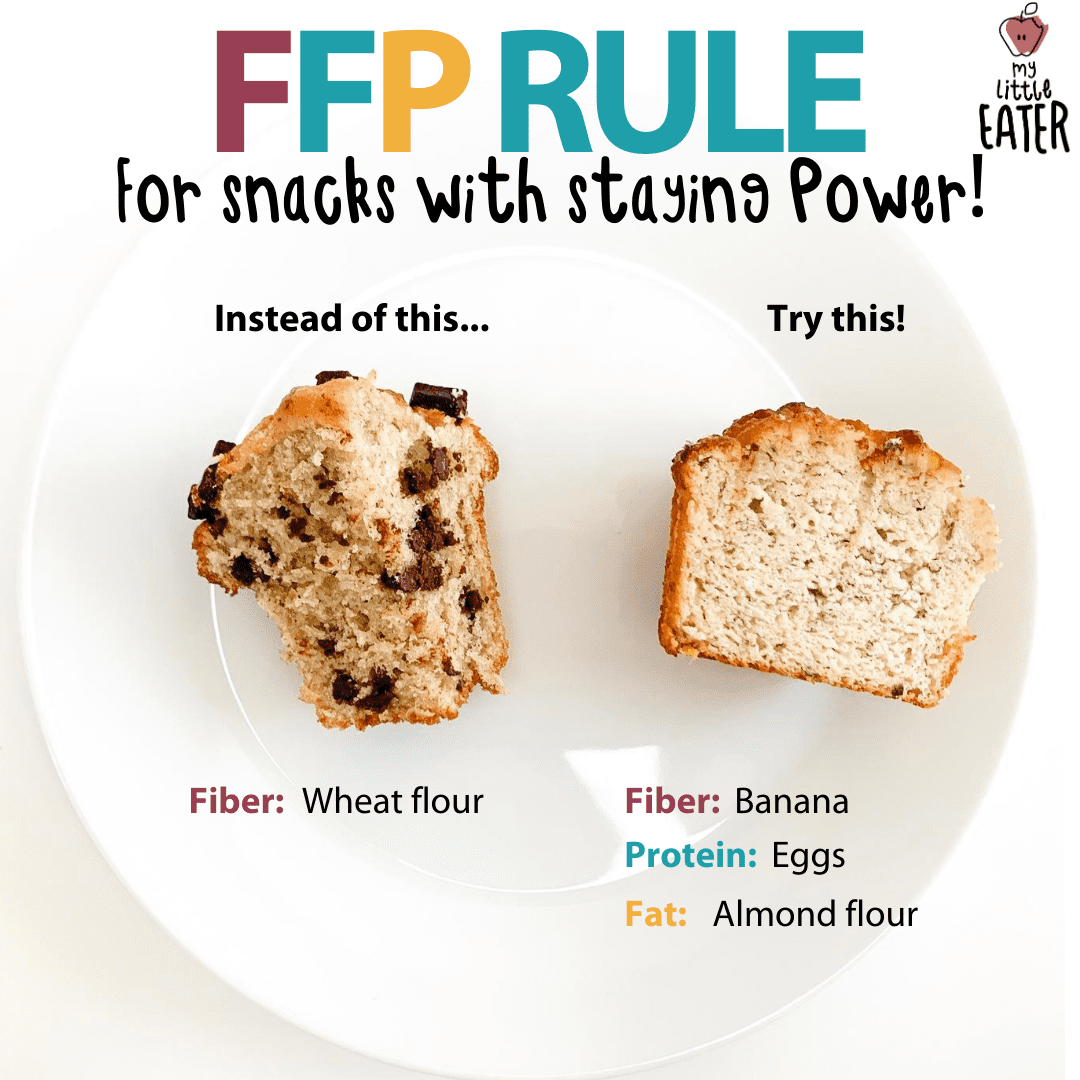
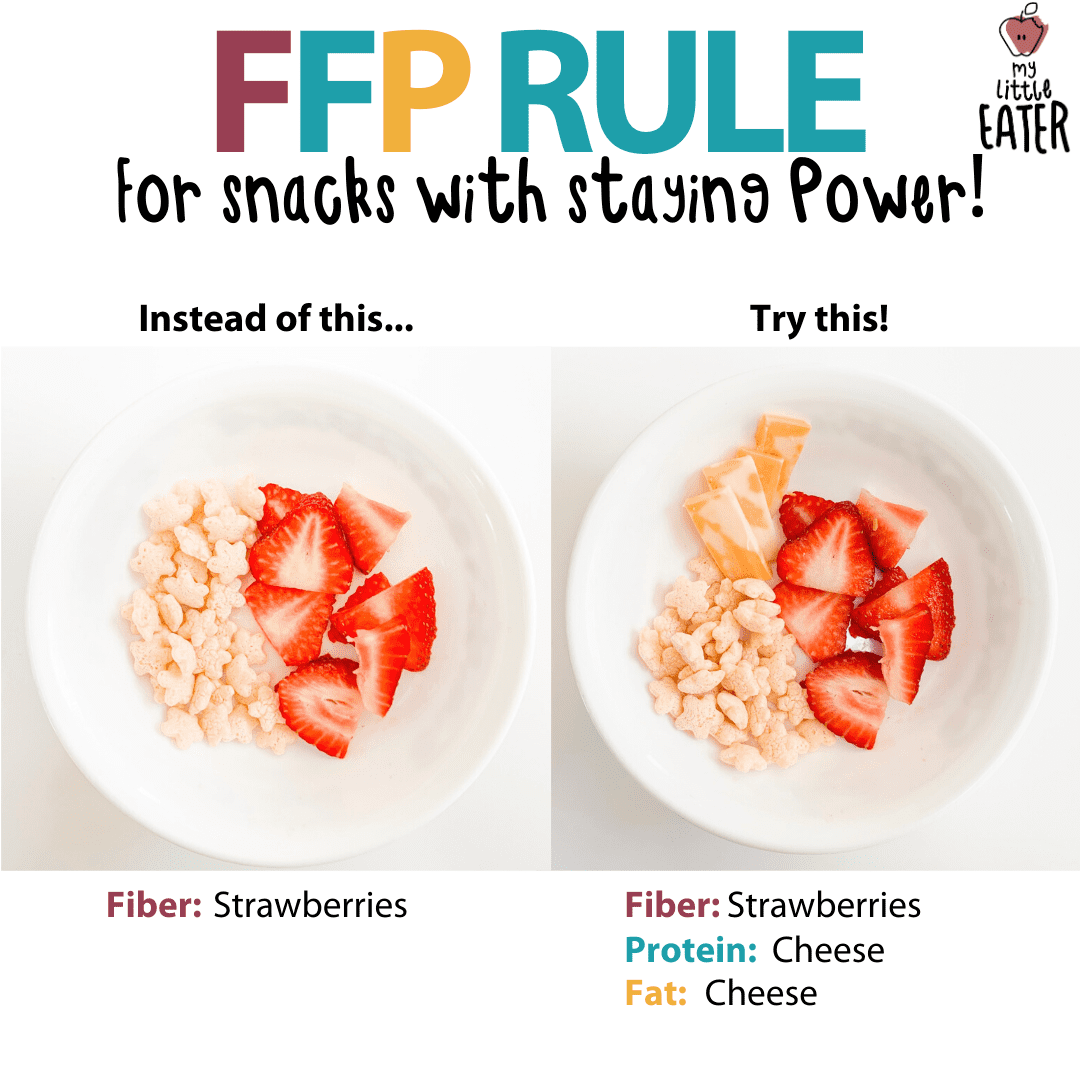
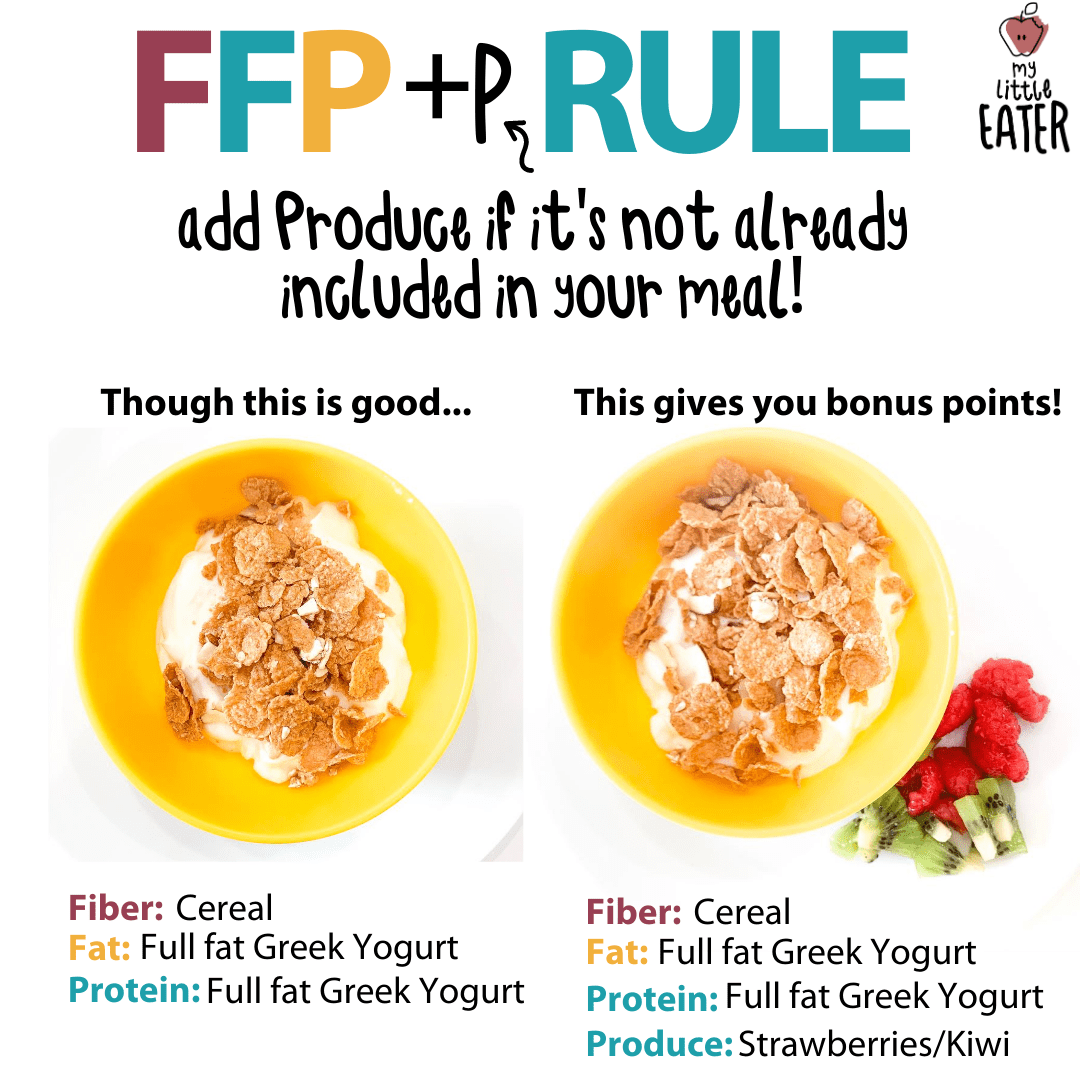
How much should I be serving?
So the next question I often get is, “So I’m offering snacks and meals with FFP foods, but how much do I offer of each?”.
I actually already have a blog post on this topic, comparing portion sizes and servings sizes, and how much your toddler actually needs!
And if you’ve taken my Feeding Toddlers online course, you know that I don’t actually want you measuring everything out at every meal. You want to allow your child to eat as much as they want from what you offer, from every food type, whether that be a little, or a lot. This may even mean refilling portions, but remember, that overall in the run of a week, the amount they eat will even out! This agrees with the feeding philosophy of the Division of Responsibility, that many feeding experts, like myself, recommend!
I hope this was helpful!
As always, if you want to learn more of my expert feeding strategies, and how to follow a streamlined approach to feeding your baby or toddler, check out my Baby Led Feeding online course and/or my Feeding Toddlers online course! I also have a membership called the Little Eaters Club where you’ll have access to baby and toddler friendly recipes that the whole family will enjoy and an ever-growing video library covering common feeding challenges and FAQs. As well as access to resources and guides to make feeding way easier, monthly coaching calls, and a community of supportive parents! Join in on the fun today! (https://mylittleeater.fixed-staging.co.uk/little-eaters-club/ )


